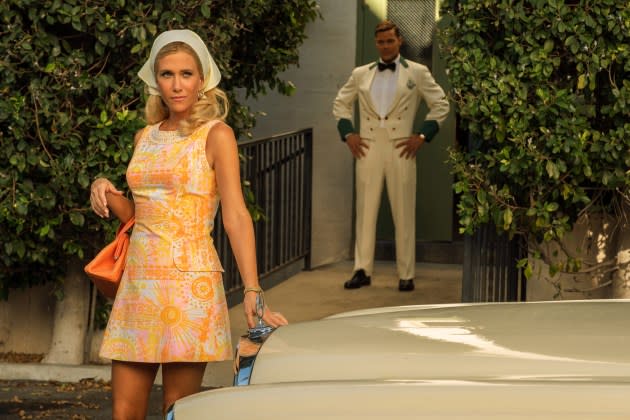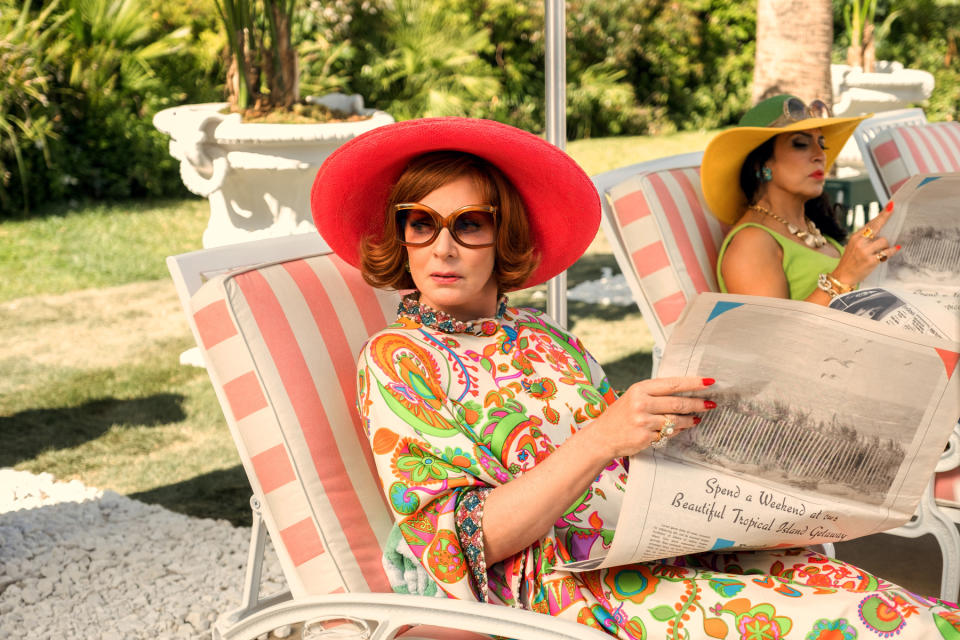‘Palm Royale’ Is a Waste of A-List Talent — and Your Precious Time
- Oops!Something went wrong.Please try again later.

In the first episode of the new Apple comedy series Palm Royale, Kristen Wiig’s Maxine tells a long, rambling story to Dinah (Leslie Bibb), a wealthy woman she’s trying to befriend. An impatient Dinah tells her, “I have lost the thread here, Maxine.”
Dinah is meant to be one of the villains of Palm Royale, forever trying to undercut Maxine’s attempts to claw her way into Palm Beach high society in the summer of 1969. Yet in this moment and many others, her complaints about Maxine ring truer than the series would probably like. Over and over, she points out the ways in which the series’ heroine, like the show itself, is both hard to follow and frequently annoying. Or, as Dinah puts it, “You’re very good at making things awkward. You must work on that.”
More from Rolling Stone
Ryan Gosling and Kristen Wiig are Headed to 'Saturday Night Live' in April
Steve Martin, 'The Most Idolized Comedian Ever,' Focus of Two-Part Documentary
Created by Dead to Me alum Abe Sylvia, Palm Royale loses the thread, early and often, on almost everything but its recreations of the gaudy fashion and decor of the era. The stacked cast — which also includes Allison Janney, Laura Dern, Ricky Martin, Josh Lucas, Carol Burnett, and Kaia Gerber, among others(*) — are all decked out in fabulous costumes, and travel through one swank set or location after another. The fourth episode is built around a lavish party with dozens of extras, elaborate dance choreography, and both the size of the budget and the level of affection for the period are palpable throughout. One of the more frequent settings is a local boutique, so that the women can argue while trying on various expensive gowns and hats.
(*) Sitcom fans of a certain age may also be happy to see Julia Duffy from Newhart and Mindy Cohn from The Facts of Life in smaller roles. With this show, you have to take the small pleasures where you can find them.
It’s the rest that’s sorely lacking. In another episode, Dinah says to Maxine, “I cannot tell if you are a country bumpkin or the most ruthless person in Palm Beach!” Palm Royale can’t quite tell, either. Or maybe it just doesn’t want to decide. At times, Maxine is presented as a slick con artist willing to take advantage of everything and everyone — including Norma (Carol Burnett), the one-time queen bee of Palm Beach, who is currently languishing in a coma(*) and thus has left her expensive home, clothes, and jewelry unguarded — who might aid her in her quest to join the local elites. At others, Maxine is the plucky underdog who is kinder and more empathetic than all of the other characters combined. Her persona morphs wildly from episode to episode, and even scene to scene, as if all anyone in the creative team was worried about was making sure a given moment would land, regardless of how it fit with everything else.
(*) Apple PR has, for reasons passing understanding, forbade me from telling you whether or not Norma ever wakes up from the coma, which in turn prevents me from in any way discussing the one part of the show I actually laughed at. (And frequently, at that!) I will simply say two things: 1) Ask yourself whether, if you were hiring one of the greatest comedy stars in television history for your show, you would have her playing a woman in a coma for an entire season? 2) If you are a person who tends to watch TV with the captions on — and if you insist on watching Palm Royale even after reading this review — I highly recommend turning them off whenever Norma is in a scene.

The problem is that very little of it lands. With the exception of Dern (as a feminist trying to discourage Maxine from becoming one of the Stepford Wives) and Martin (as an employee of the titular club who is wise to Maxine’s game long before everyone else), everyone is playing a cartoon, and giving a performance to match. The characters are all too broad by half, making the periodic stabs at genuine emotion feel besides the point, and making nearly all of the comedy feel simply labored(*). The tone is as susceptible to whiplash as the characterization: one episode concludes with Maxine having a conversation with a whale, while another concludes with an act of violence that leaves multiple characters screaming and crying in slow-motion. And there are 10 long episode — ranging from 45 minutes to an hour — of this.
(*) Again, other than the thing Apple doesn’t want me to tell you about, all to preserve a surprise that will in fact surprise no one. Then again, the show features several big plot twists that are so blatantly telegraphed, I was startled to realize several episodes later that they were actually meant to be twists.
Think about all the talent on display here: Wiig and Burnett are comedy icons to different generations. Janney and Dern have Oscars. The cast has a combined 14 acting Emmys and more than 60 Emmy nominations between them. Apple has clearly spared no expense on this, and the season-ending cliffhanger makes clear this is not just an Emmy-bait miniseries, but something that’s being counted on as a big ongoing show. But by the time Maxine is warbling Peggy Lee’s “Is That All There Is?” during the weirdly melodramatic finale, viewers will not be blamed for asking the same question about what all these people have joined forces to make.
The first three episodes of Palm Royale begin streaming March 20 on Apple TV+, with additional episodes releasing weekly. I’ve seen all 10 episodes.
Best of Rolling Stone

